Influence of Basalt Fiber on Mechanical Properties and Microstructure of Rubber Concrete
Abstract
:1. Introduction
2. Experimental Program
2.1. Performance Parameters of Raw Materials
2.2. Concrete Mix Design and Molding
2.3. Test Methods of Mechanical Properties
2.4. Microstructure Analysis
3. Experimental Results
3.1. Concrete Failure Mode
3.2. Strength Analysis
3.3. SEM Analysis
3.4. Distribution of Rubber Particles in Concrete
4. Conclusions
- (1)
- In the process of the compression test and splitting tensile test, the concrete of the OC group showed obvious characteristics of brittle failure, while the concrete of the RC group and BFRC group showed characteristics of ductile failure. Compared with the compressive strength and splitting tensile strength, the basalt fiber had no obvious effect on improving the compressive strength of rubber concrete. Its main role was to give play to the characteristics of tensile strength of fiber to improve the splitting tensile strength of rubber concrete.
- (2)
- The addition of fiber could delay the generation of the initial crack of the test block. When the crack occurred, the stress between the fibers was redistributed, the fiber and the matrix were stressed at the same time, and the stress concentration between the cracks was alleviated, thus restraining crack propagation.
- (3)
- The incorporation of rubber particles introduced a large number of pores, which were unevenly distributed. The incorporation of basalt fiber could refine the macropores and make the pore distribution more uniform. The rubber particles were evenly distributed in the concrete.
Author Contributions
Funding
Institutional Review Board Statement
Informed Consent Statement
Data Availability Statement
Conflicts of Interest
References
- Mayhoub, O.A.; Abadel, A.A.; Alharbi, Y.R. Effect of Polymers on Behavior of Ultra-High-Strength Concrete. Polymers 2022, 14, 2585. [Google Scholar] [CrossRef] [PubMed]
- Lamiaa, A.; Yasser, A. Properties of Rubberized Concrete Prepared from Different Cement Types. Recycling 2022, 7, 39. [Google Scholar]
- Fedroff, D.; Ahmad, S. Mechanical Properties of Concrete with Ground Waste Tire Rubber. Transp. Res. Rec. 1996, 1532, 66–72. [Google Scholar] [CrossRef]
- Qi, C.H. Study on Mechanical Properties and Fracture Toughness of Porous Cement Concrete with Polymer Rubber Framework; Chongqing Jiaotong University: Chongqing, China, 2020. [Google Scholar]
- Xiong, J.; Zheng, L.; Yuan, Y. Experimental study on compressive strength of waste rubber concrete. Concrete 2004, 12, 40–42. [Google Scholar]
- Yu, Z.; Tang, R.; Li, F. Experimental Study and Failure Criterion Analysis on Combined Compression-Shear Performance of Rubber Concrete (RC) with Different Rubber Replacement Ratio. Constr. Build. Mater. 2021, 288, 123105. [Google Scholar] [CrossRef]
- Atahan, A.O.; Yücel, A.Ö. Crumb Rubber in Concrete: Static and Dynamic Evaluation. Constr. Build. Mater. 2012, 36, 617–622. [Google Scholar] [CrossRef]
- Zhao, Q.; Dong, S.; Zhu, H.; Yu, Y. Stress strain relationship of steel fiber reinforced rubber concrete under cyclic compression. J. Build. Mater. 2022, 1–13. [Google Scholar]
- Pang, J.; Zhang, Q.; Yao, W.; Su, Q. Mechanical property test of steel fiber reinforced rubber concrete. Chin. Sci. Technol. Pap. 2020, 15, 1302–1307. [Google Scholar]
- Zhang, E.; Lu, G.; Yang, H.; Zhao, Z. Experimental study on working and mechanical properties of polypropylene fiber reinforced rubber concrete. Concrete 2021, 86–89. [Google Scholar]
- Chen, A.; Chen, M.; Wang, D.; Hu, F.; Li, H. Experimental study on the basic properties of polypropylene fiber recycled rubber concrete. Concrete 2014, 57–60. [Google Scholar]
- Wang, J.; Wu, F.; Li, F. Experimental study on improving mechanical properties of rubber concrete with carbon fiber and micro silica fume. China Water Transp. 2021, 21, 158–160. [Google Scholar]
- Han, K. Properties and Mechanism of Multi-Scale Fiber Reinforced Cementitious Materials; Harbin Institute of Technology: Harbin, China, 2017. [Google Scholar]
- Yang, C.C.; Bai, Y. Study on the mechanical properties of rubber-doped powder and fiber concrete. China Sci. Technol. Pap. 2016, 11, 1548–1550. [Google Scholar]
- Zhang, S.; Bai, Y. Mechanical properties tests and microscopic analysis of basalt fiber-doped rubber light-aggregate concrete. World Concr. 2020, 66–69. [Google Scholar]
- He, D.; Wang, J. Effect of rubber doping on physical and mechanical properties of CBFRC. J. Constr. Mater. 2015, 18, 857–860. [Google Scholar]
- Chen, A.; Chen, M. Effect of basalt fibers on the mechanical properties of rubber recycled concrete. Concrete 2015, 59–62. [Google Scholar]
- Tan, Y. Computed tomography. J. Bethune Med. Univ. 1979, 120–128. [Google Scholar]
- Ruan, X.; Akiyama, M. Modelling Method of Fiber Distribution in Steel Fiber Reinforced Concrete Based on X-Ray Image Recognition. Compos. Part B Eng. 2021, 223, 109124. [Google Scholar]
- Li, N. Research progress in studying internal damage of concrete based on X-ray CT technology. Mater. Guide 2021, 35, 21169–21177. [Google Scholar]
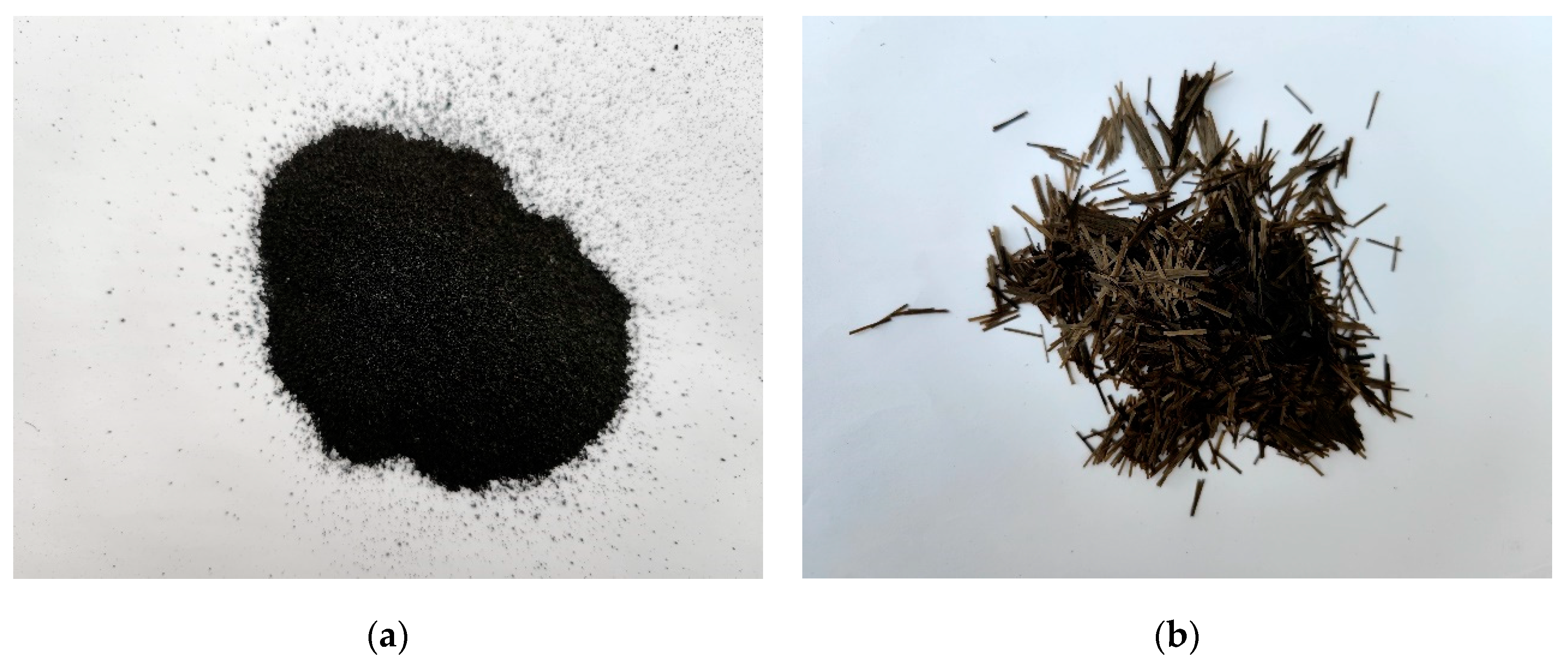
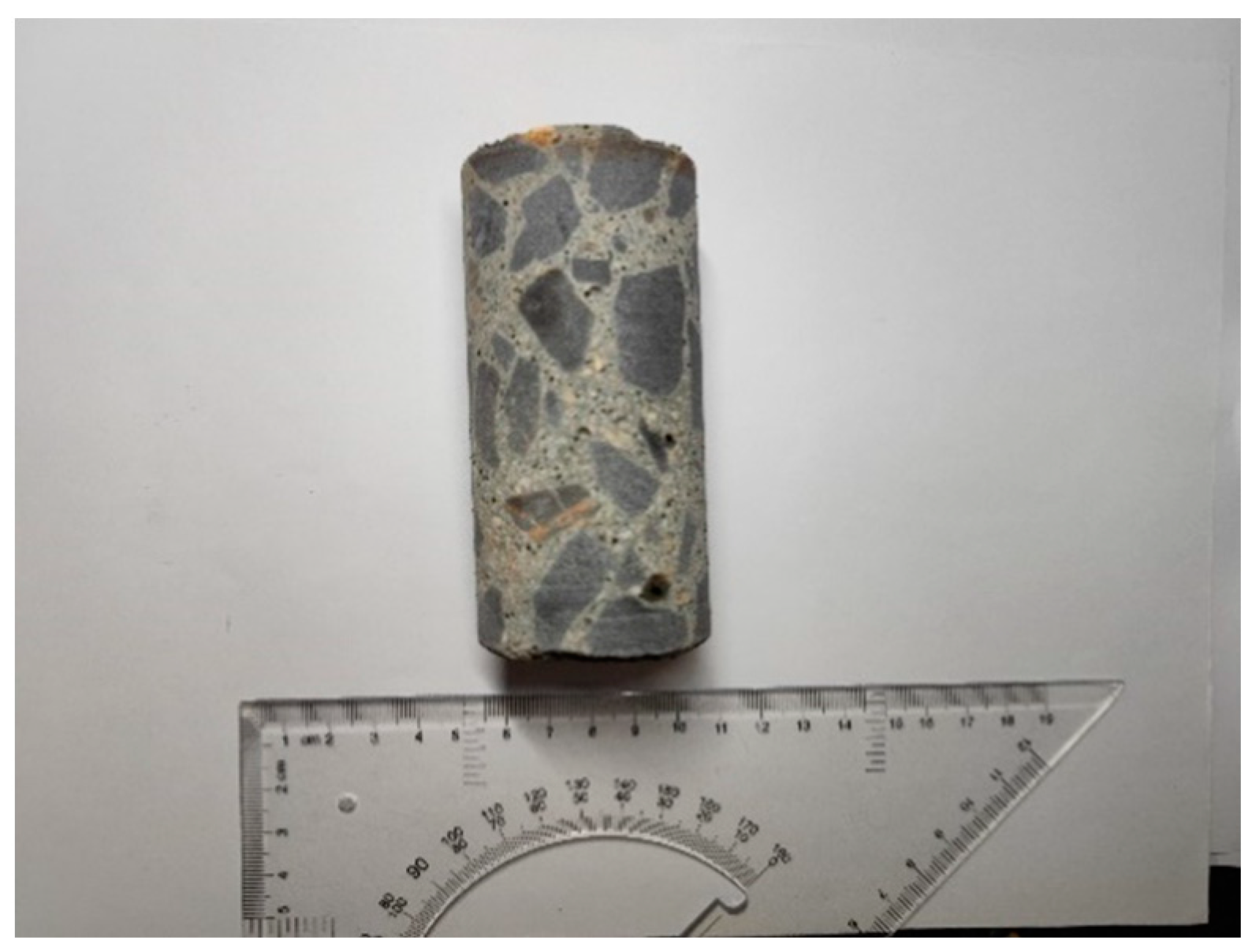

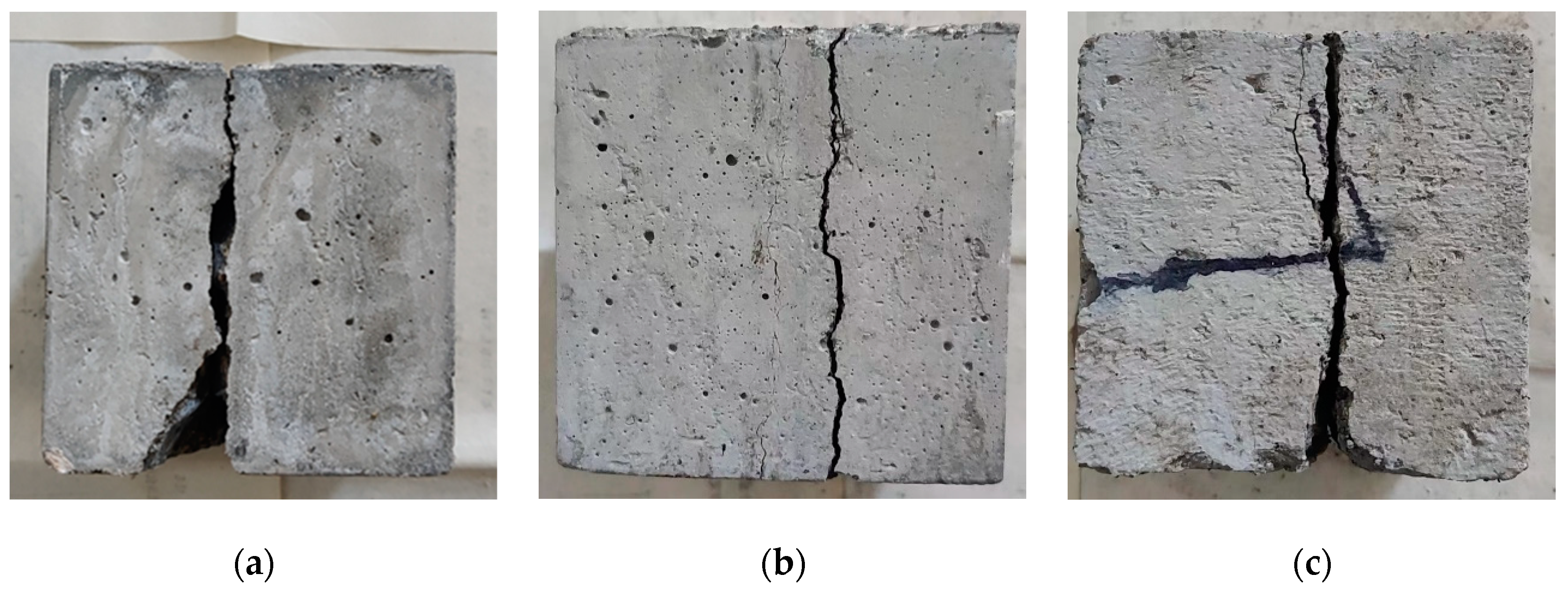
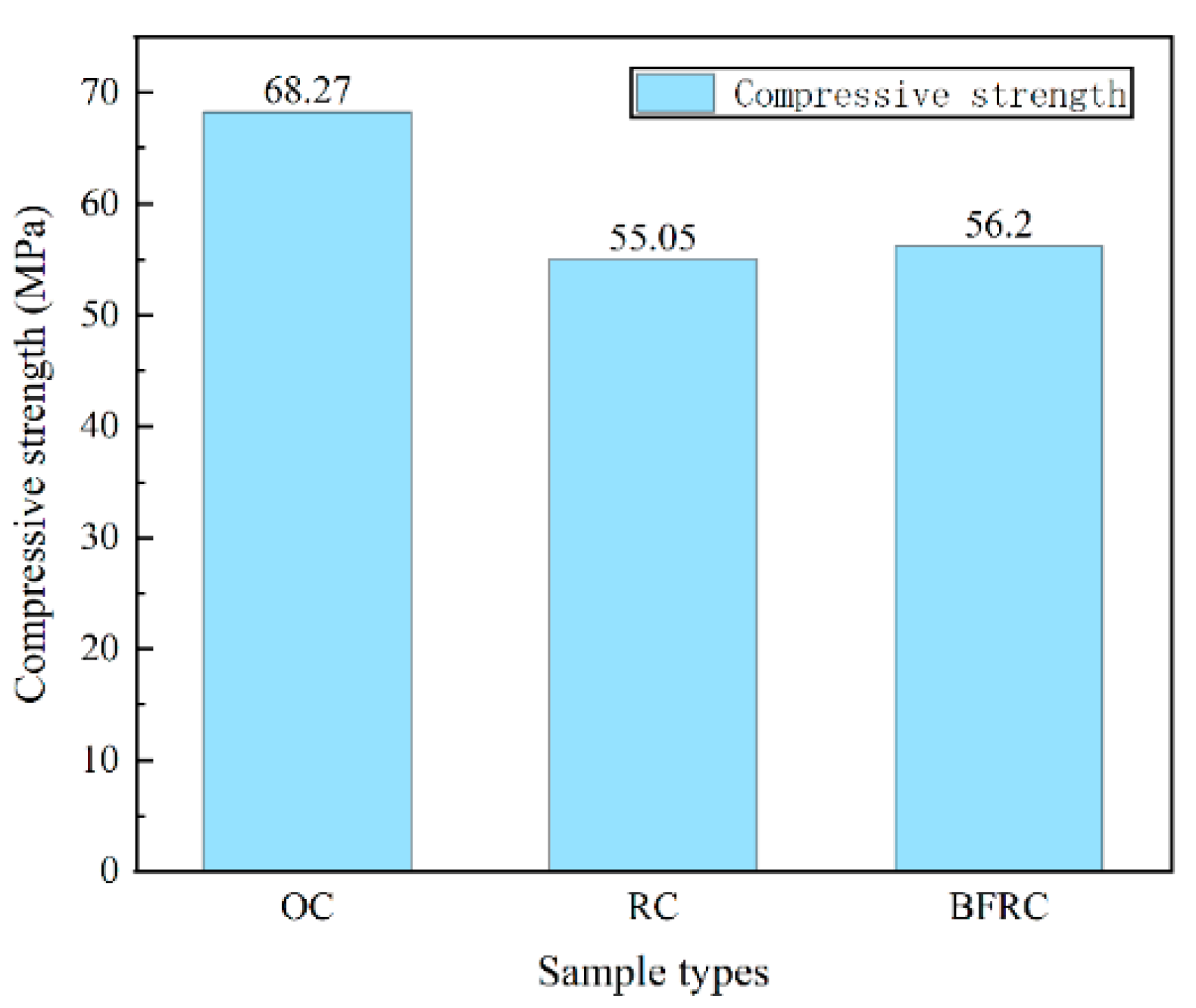
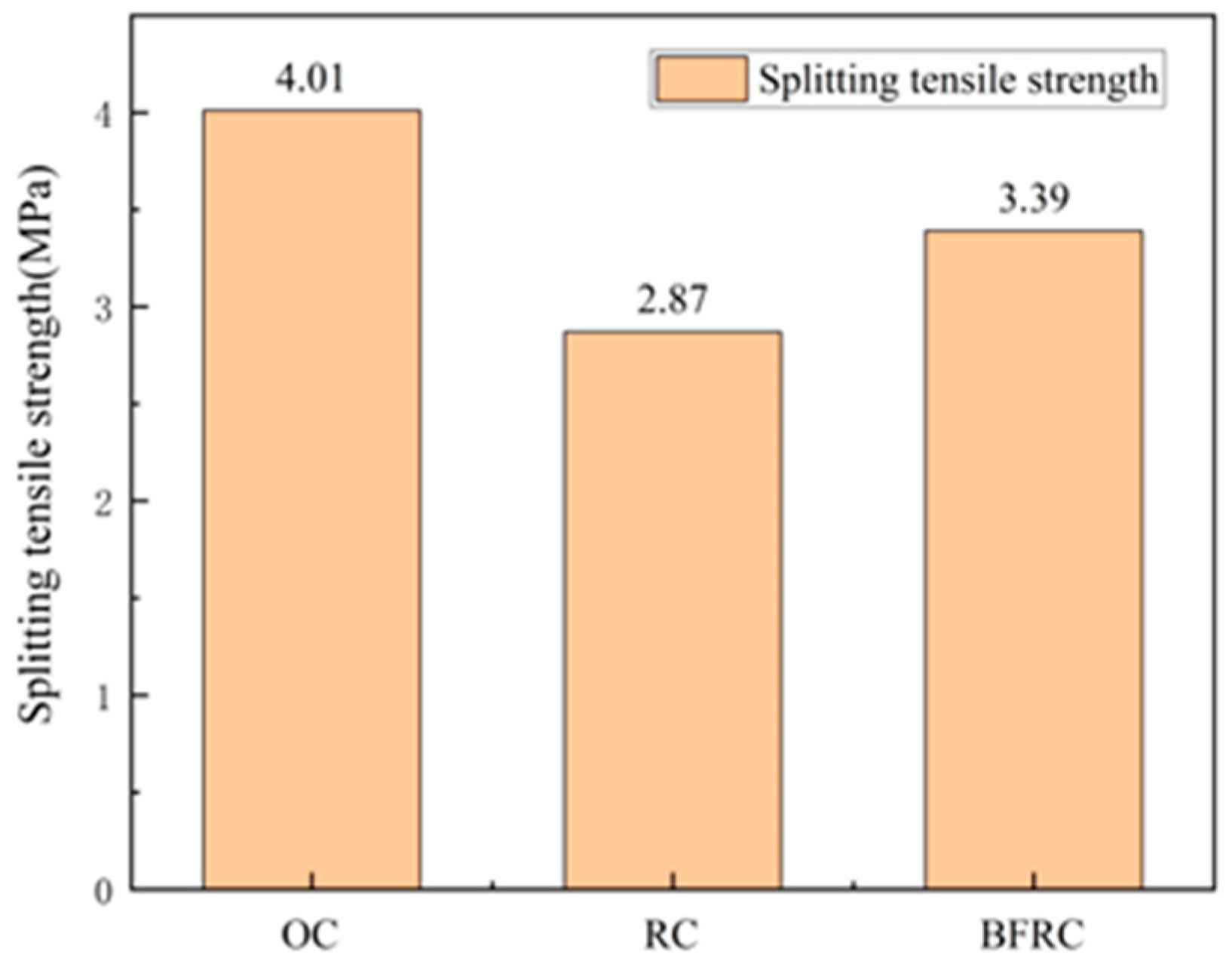
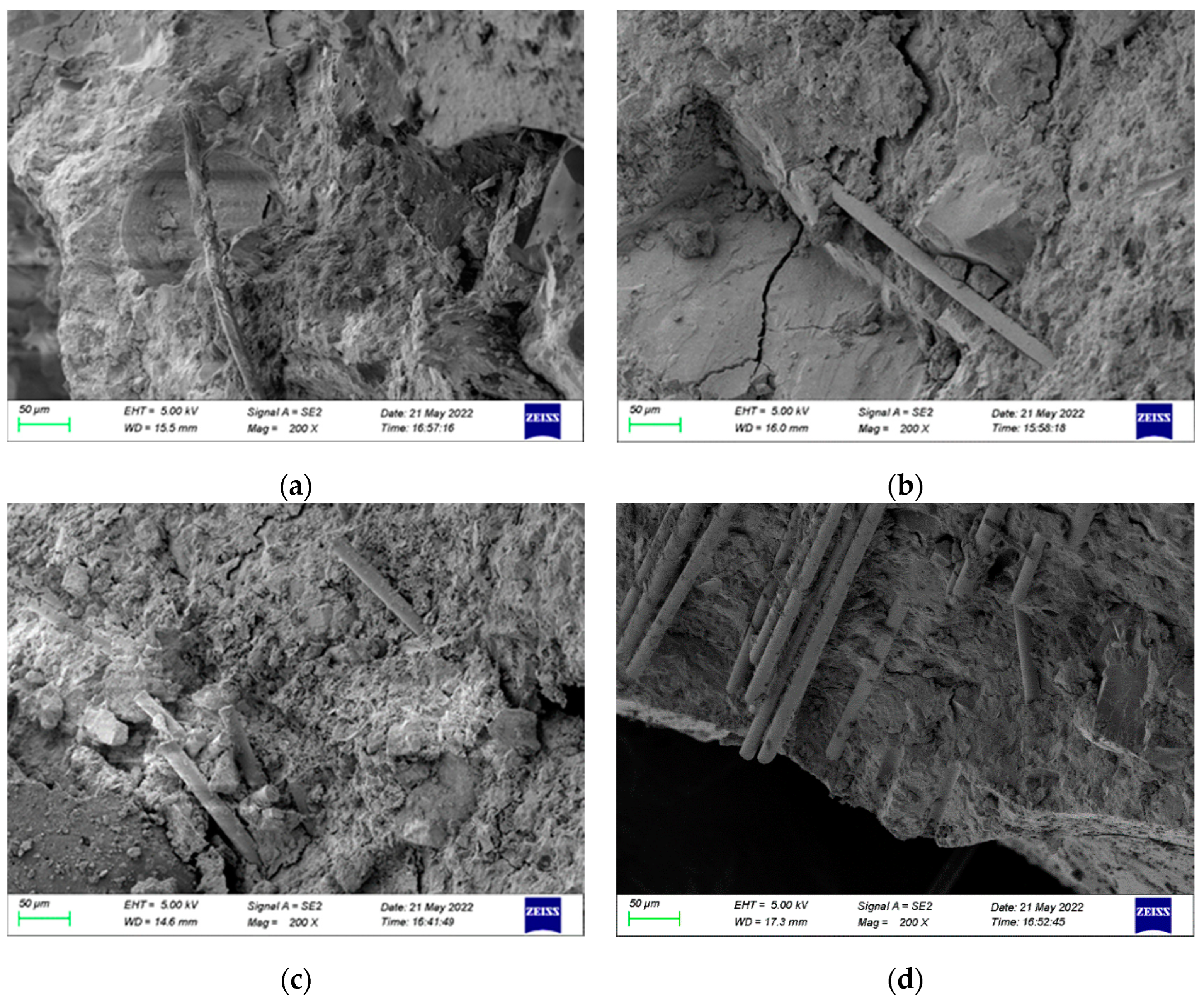
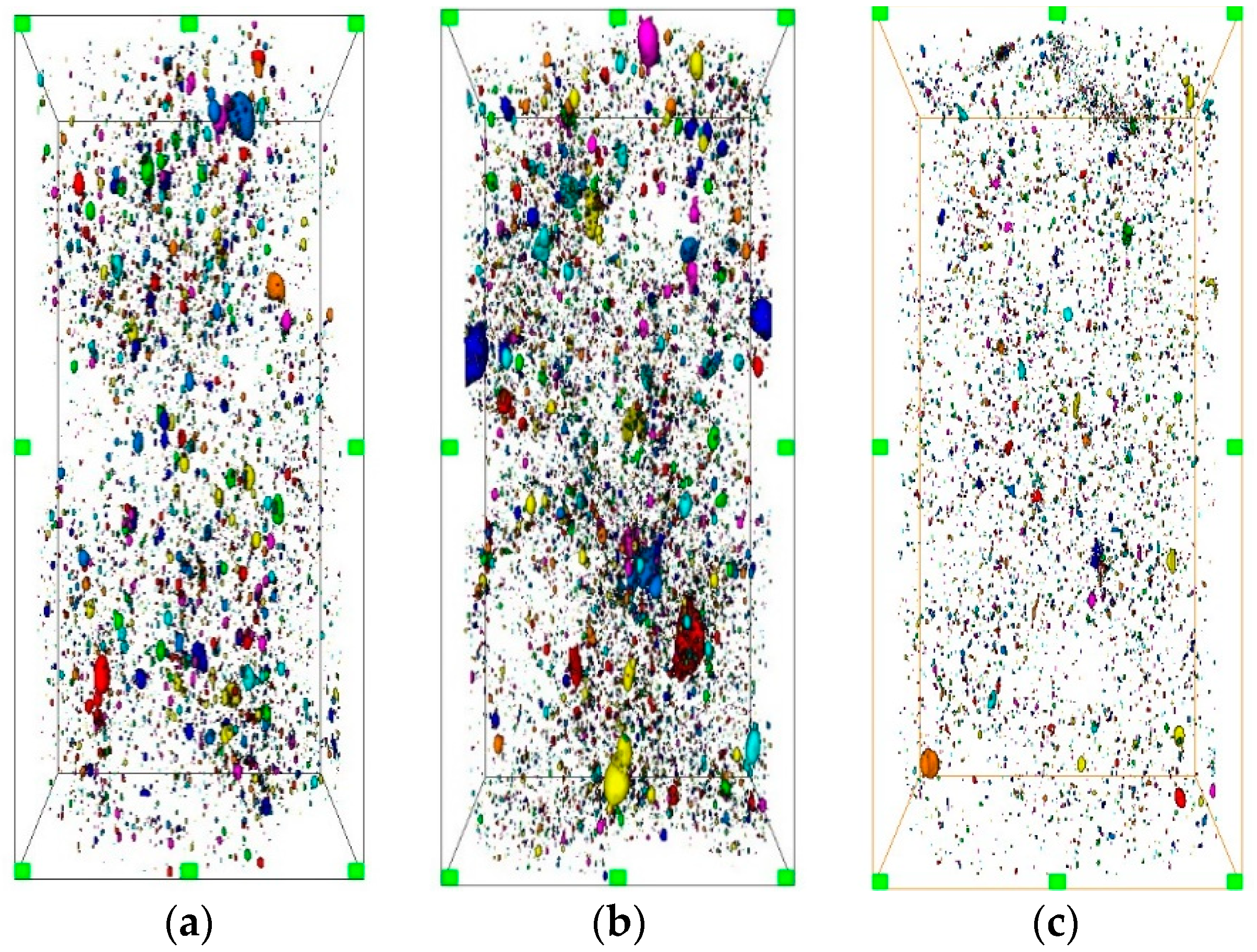
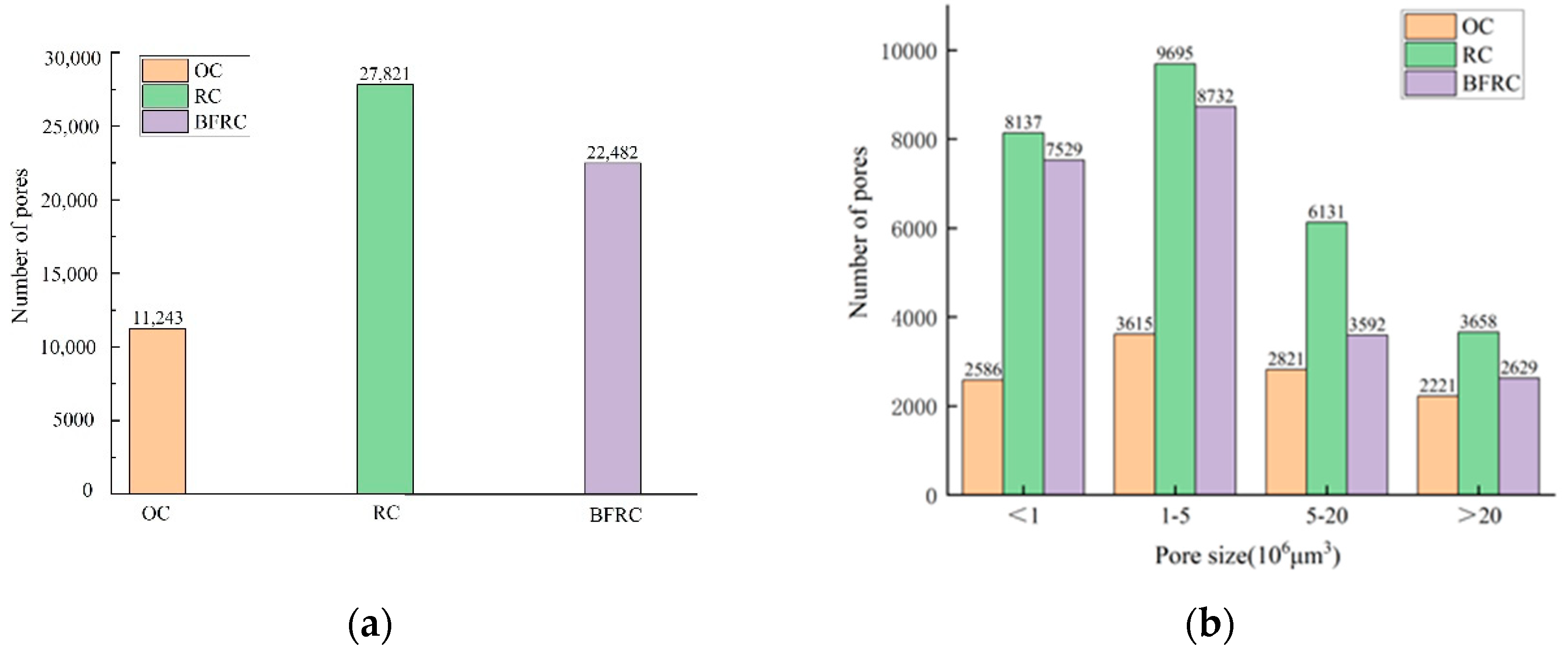
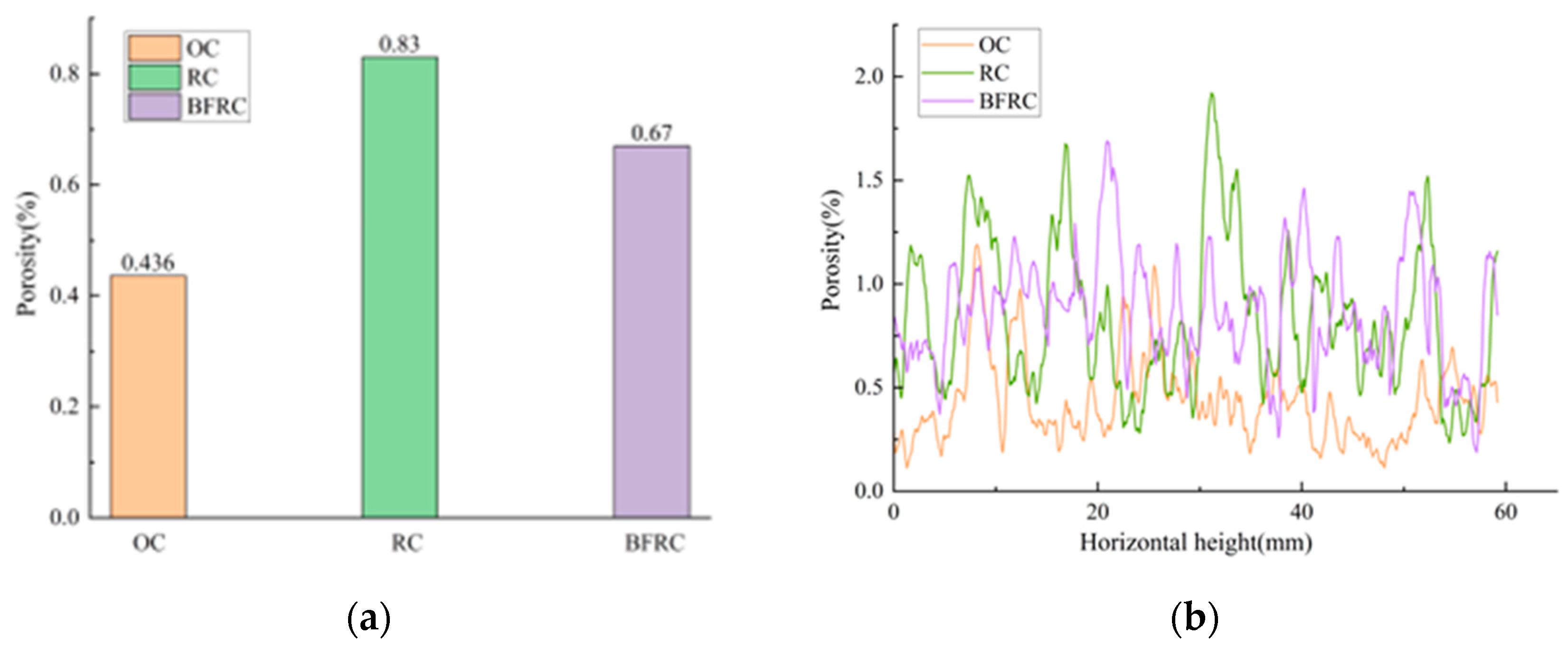
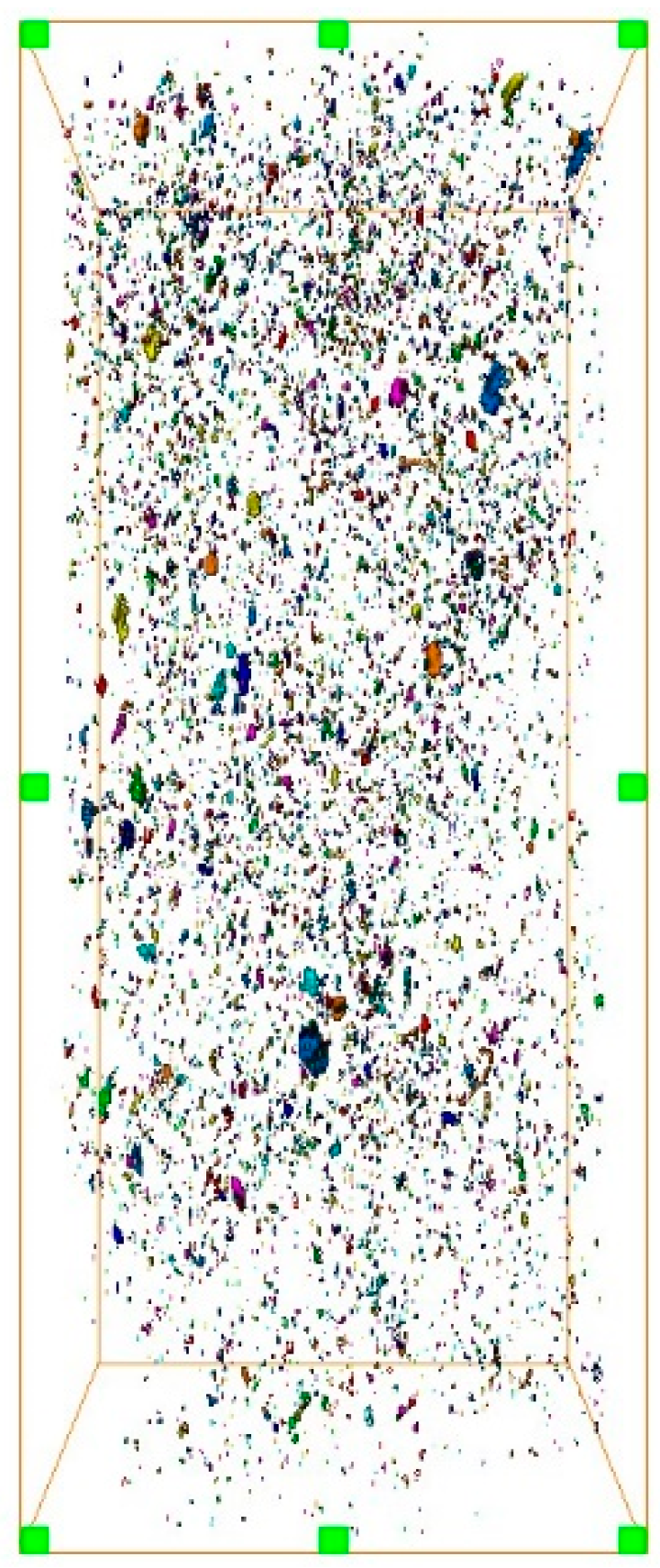
| Chemical Composition | CaO | SiO2 | Al2O3 | Fe2O3 | MgO | SO3 | Others |
|---|---|---|---|---|---|---|---|
| Cement | 61.74 | 16.44 | 4.78 | 3.52 | 2.67 | 3.69 | 7.16 |
| Particle Size (mm) | Apparent Density (g/cm3) | Bulk Density (g/cm3) | Water Content (%) | Ash Content (%) |
|---|---|---|---|---|
| 0.85 | 1.5 | 0.331 | 1.8 | 5.7 |
| Density (g/cm3) | Breaking Load (N) | Tensile Strength (MPa) | Elastic Modulus (GPa) | Breaking Elongation (%) |
|---|---|---|---|---|
| 2.61 | 44.38 | 416.8 | 850 | 1.50 |
| Sample Types | Cement (kg) | Fine Aggregate (kg) | Coarse Aggregate (kg) | Water (kg) | Rubber Particles (kg) | Basalt Fiber (kg) | Superplasticizer (g) |
|---|---|---|---|---|---|---|---|
| OC | 513.08 | 661.54 | 1074.47 | 185.00 | 0 | 0 | 685.77 |
| RC | 513.08 | 624.15 | 1074.47 | 185.00 | 21.41 | 0 | 685.77 |
| BFRC | 513.08 | 624.15 | 1074.47 | 185.00 | 21.41 | 2.6 | 685.77 |
| Sample Types | Data 1 (MPa) | Data 2 (MPa) | Data 3 (MPa) | Average Splitting Tensile Strength (MPa) | Standard Deviation |
|---|---|---|---|---|---|
| OC | 67.71 | 68.24 | 68.86 | 68.27 | 0.576 |
| RC | 54.12 | 54.28 | 56.75 | 55.05 | 1.474 |
| BFRC | 55.72 | 56.48 | 56.4 | 56.20 | 0.417 |
| Sample Types | Data 1 (MPa) | Data 2 (MPa) | Data 3 (MPa) | Average Splitting Tensile Strength (MPa) | Standard Deviation |
|---|---|---|---|---|---|
| OC | 3.98 | 4.12 | 3.93 | 4.01 | 0.098 |
| RC | 2.75 | 3.12 | 2.74 | 2.87 | 0.216 |
| BFRC | 3.28 | 3.65 | 3.24 | 3.39 | 0.226 |
Publisher’s Note: MDPI stays neutral with regard to jurisdictional claims in published maps and institutional affiliations. |
© 2022 by the authors. Licensee MDPI, Basel, Switzerland. This article is an open access article distributed under the terms and conditions of the Creative Commons Attribution (CC BY) license (https://creativecommons.org/licenses/by/4.0/).
Share and Cite
Wang, X.; Shao, J.; Wang, J.; Ma, M.; Zhang, B. Influence of Basalt Fiber on Mechanical Properties and Microstructure of Rubber Concrete. Sustainability 2022, 14, 12517. https://doi.org/10.3390/su141912517
Wang X, Shao J, Wang J, Ma M, Zhang B. Influence of Basalt Fiber on Mechanical Properties and Microstructure of Rubber Concrete. Sustainability. 2022; 14(19):12517. https://doi.org/10.3390/su141912517
Chicago/Turabian StyleWang, Xiao, Jinggan Shao, Junchao Wang, Minghao Ma, and Bing Zhang. 2022. "Influence of Basalt Fiber on Mechanical Properties and Microstructure of Rubber Concrete" Sustainability 14, no. 19: 12517. https://doi.org/10.3390/su141912517
APA StyleWang, X., Shao, J., Wang, J., Ma, M., & Zhang, B. (2022). Influence of Basalt Fiber on Mechanical Properties and Microstructure of Rubber Concrete. Sustainability, 14(19), 12517. https://doi.org/10.3390/su141912517





